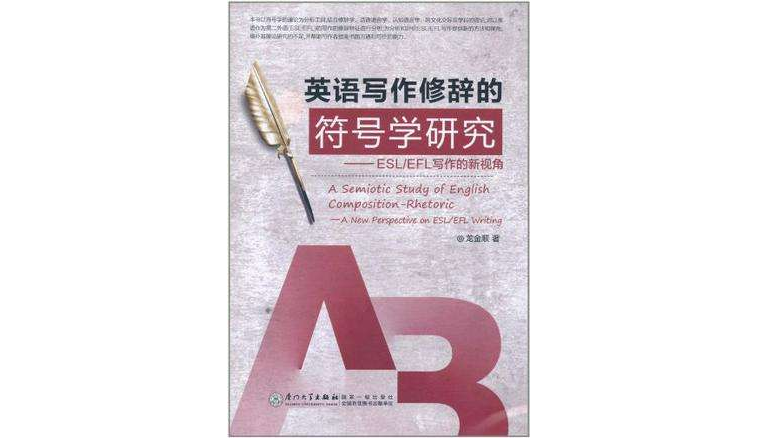《英語寫作修辭的符號學研究》是2011年廈門大學出版社出版的圖書,作者是龍金順。
基本介紹
- 書名:英語寫作修辭的符號學研究
- 作者:龍金順
- ISBN:9787561538326
- 頁數:238
- 定價:27.00元
- 出版社:廈門大學出版社
- 出版時間:2011-4
- 副標題:ESL\EFL寫作的新視角
內容簡介,目錄,文摘,
內容簡介
《英語寫作修辭的符號學研究:ESL/EFL寫作的新視角》以符號學的理論為分析工具,結合修辭學、話語言學、認知語言學、跨文化交際等學科的理論,對以英語作為第二外語(ESL/EFL)的寫作的修辭特徵進行分析,為分析和評價SEL/EFL寫作提供新的方法和視角,填補其理論研究的不足,並幫助寫作者提高書面溝通和寫作的能力。
目錄
Prcface
Acknowledgements
Introduction
0.1 The State of AffairS 0f ESLEEL Writing
0.1.1 The Definitions of ESLEFL Writln2
0.1.2 Background to This Research
0.1.3 Studies in Europe and America
0.1.4 Studies in China
0.2 Summary
0.3 The Problems of ESLEEL Composition Studies
0.4 0bjectives and Research Questions of This Study
0.5 Methodology and Significance of This Study
0.6 0utline of This Book
Chapter 1 The Nature and Development of Semiotics
1.1 The Nature of Semiotics
1.2 Research by Western Scholars
1.3 Research by Chinese Scholars
1.3.1 Studies of Linguistic Semiotics
1.3.2 The Application of Studies of Semiotics
1.4 Summary
Chapter 2 Different Semiotic Schools and Key Semiotic Concepts
2.1 Structural Semiotics and Key Concepts
2.1.1 Signifier and Signified
2.1.2 Syntagmatic and Paradigmatic Relations
2.2 Interpretative Semiotics and Some Key Concepts
2.2.1 Semiosis
2.2.2 Sign, Object and Interpretant
2.2.3 Indexical, Iconic and Symbolic Signs
2.3 Social Semiotics and Some Key Concepts
2.3.1 Code, Encode and Decode
2.3.2 Mode of Locating a Text
2.4 Cultural Semiotics and Some Key Concepts
2.4.1 Connotation, Denotation and Myth
2.4.2 Semiosphere
2.5 Summary
Chapter 3 Semiotics, Rhetoric and Composition-Rhetoric
3.1 Semiotics and Language
3.2 Semiotics and Rhetoric
3.2.1 The Triangle of Rhetoric
3.2.2 The Relationship Between Semiotics and Rhetoric
3.3 Semiotics and Composition-Rhetoric
3.3.1 The Basic Elements of Classical Rhetoric
3.3.2 Composition-Rhetoric and Multimodality
3.3.3 Interdisciplinary Composition-Rhetoric
3.4 Summary
Chapter 4 Codes and Composition-Rhetoric
4.1 Code and Sign
4.2 Kinds of Code
4.3 Code and Text
4.4 Codes in Composition-Rhetoric
4.4.1 Context
4.4.2 Rhetorical Situation
4.4.3 Strategies for Writing
4.4.4 Textual Structures
4.4.5 Text Features/100
4.4.6 Figurative Language
……
Chapter 5 Semiotics,Rhetorie and Text
Chapter 6 The Semiotic Analysis of Composition-Rhetoric
Chapter 7 Cultural Semiotic Analysis of Composition-Rhetorie
Conclusion
Works Cited
Acknowledgements
Introduction
0.1 The State of AffairS 0f ESLEEL Writing
0.1.1 The Definitions of ESLEFL Writln2
0.1.2 Background to This Research
0.1.3 Studies in Europe and America
0.1.4 Studies in China
0.2 Summary
0.3 The Problems of ESLEEL Composition Studies
0.4 0bjectives and Research Questions of This Study
0.5 Methodology and Significance of This Study
0.6 0utline of This Book
Chapter 1 The Nature and Development of Semiotics
1.1 The Nature of Semiotics
1.2 Research by Western Scholars
1.3 Research by Chinese Scholars
1.3.1 Studies of Linguistic Semiotics
1.3.2 The Application of Studies of Semiotics
1.4 Summary
Chapter 2 Different Semiotic Schools and Key Semiotic Concepts
2.1 Structural Semiotics and Key Concepts
2.1.1 Signifier and Signified
2.1.2 Syntagmatic and Paradigmatic Relations
2.2 Interpretative Semiotics and Some Key Concepts
2.2.1 Semiosis
2.2.2 Sign, Object and Interpretant
2.2.3 Indexical, Iconic and Symbolic Signs
2.3 Social Semiotics and Some Key Concepts
2.3.1 Code, Encode and Decode
2.3.2 Mode of Locating a Text
2.4 Cultural Semiotics and Some Key Concepts
2.4.1 Connotation, Denotation and Myth
2.4.2 Semiosphere
2.5 Summary
Chapter 3 Semiotics, Rhetoric and Composition-Rhetoric
3.1 Semiotics and Language
3.2 Semiotics and Rhetoric
3.2.1 The Triangle of Rhetoric
3.2.2 The Relationship Between Semiotics and Rhetoric
3.3 Semiotics and Composition-Rhetoric
3.3.1 The Basic Elements of Classical Rhetoric
3.3.2 Composition-Rhetoric and Multimodality
3.3.3 Interdisciplinary Composition-Rhetoric
3.4 Summary
Chapter 4 Codes and Composition-Rhetoric
4.1 Code and Sign
4.2 Kinds of Code
4.3 Code and Text
4.4 Codes in Composition-Rhetoric
4.4.1 Context
4.4.2 Rhetorical Situation
4.4.3 Strategies for Writing
4.4.4 Textual Structures
4.4.5 Text Features/100
4.4.6 Figurative Language
……
Chapter 5 Semiotics,Rhetorie and Text
Chapter 6 The Semiotic Analysis of Composition-Rhetoric
Chapter 7 Cultural Semiotic Analysis of Composition-Rhetorie
Conclusion
Works Cited
文摘
The interdisciplinary nature: The state of modem life requireshumans to make careful division of labor in human intelligence, whichis manifested in continuous division of research objects and researchmethods, forming a series of natural and social sciences. Thespecialization of knowledge, of course, embodies the progress of thehuman civilization. However, it has inevitably brought about somenegative effects, the typical example of which is that disciplines gotheir own ways, independent of each other so that there is a lack ofmutual link and communication between disciplines, resulting in theduplication of work and the waste of resources. Faced with thisoverspecialization, more and more scholars have deeply felt the need ofinterdisciplinary exchanges. Semiotics, one of the effective strategiesresponding to this requirement, takes all forms of semiosis as researchobjects or observation angles, intended to restore the links anddialogues between disciplines, and between theories and life-world. Inthis sense, the emergence and development of semiotics has derivedfrom the needs of modem knowledge structures(Ding Ershu 9).
In the true interdisciplinary spirit, semiotics crosses over the fixedboundaries of academic research. Semiotics is an overarchingconception that provides a stronger basis for interdisciplinary studiesthan traditional rationales like the humanities. Just as Li Youzhenpointed out(97) : People are both to understand the objects correctly inorder to analyze them, and to strengthen the links between relatedobjects. This process is actually in agreement with the development ofnatural science. The so-called interdisciplinary phenomena in naturaland human sciences are entirely for the need of precision, and deploy,combine and comprehensively apply existing means (multidisciplinaryapproaches) so as to expand and refine the description of the object.The interdisciplinary features of semiotic studies are above all theinclination to atomize or systematize all the traditional research objects.
In the true interdisciplinary spirit, semiotics crosses over the fixedboundaries of academic research. Semiotics is an overarchingconception that provides a stronger basis for interdisciplinary studiesthan traditional rationales like the humanities. Just as Li Youzhenpointed out(97) : People are both to understand the objects correctly inorder to analyze them, and to strengthen the links between relatedobjects. This process is actually in agreement with the development ofnatural science. The so-called interdisciplinary phenomena in naturaland human sciences are entirely for the need of precision, and deploy,combine and comprehensively apply existing means (multidisciplinaryapproaches) so as to expand and refine the description of the object.The interdisciplinary features of semiotic studies are above all theinclination to atomize or systematize all the traditional research objects.

